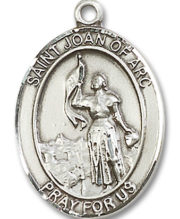$58.99 – $1,254.00
St. Joan Of Arc Medal
- St. Joan of Arc is the patron saint of France, service women, and virgins.
- St. Joan of Arc’s feast day is celebrated on May 30th.
This St. Joan Of Arc medal has been proudly hand-made for over a century by Bliss’ team of artists in Rhode Island. The St. Joan Of Arc medal is crafted to last a lifetime.
St. Joan Of Arc Medal
This St. Joan Of Arc Medal and Necklace features a pendant with a hand pressed image of St. Joan of Arc surrounded by the words ‘St. Joan Of Arc Pray for Us’.
Sterling Silver St. Joan Of Arc Medal and Necklace
14KT Gold Filled St. Joan Of Arc Medal and Necklace
14KT Gold St Joan Of Arc Medal
ST. JOAN OF ARC
Introduction
During the reign of Edward III, England waged against France a war which lasted a hundred years. Consequently, France had been a prey to misfortune during that long period of time. When France was at its darkest hour, when all seemed lost, God raised up Saint Joan of Arc to revive the hopes of the discouraged soldiers. Jeannette or, as she was afterwards called, Jeanne d’Arc, was born on February 6, 1412, in the little village of Domremy, about 140 miles southeast of Paris, on the banks of the Meuse and bordering on Lorraine. Her parents were hard-working, faithful, pious Catholics. St. Joan had one sister and three brothers. Her days were spent with the usual occupations of a peasant girl. She was well brought up and attended daily Mass.
Voices
The tide of war had reached the borders of Lorraine. Joan was forced more than once to fly into the woods with her parents before bands of robbers, who sacked and burnt their home. Her mind was full of the terrible events of the times. Distinguished by her virtues and piety, her soul was ready to do God’s Will. When the message came, she heard and saw and obeyed. Here, in her own simple words, is the story of the first coming: “I was thirteen when I had a Voice from God for my help and guidance. The first time I heard this Voice I was very much frightened; … The Voice seemed to come to me from lips I should reverence, I believe it was sent me from God. When I heard it for the third time I rec that it was the Voice of an Angel”. Her first Voice came with a vision of St. Michael, whom she saw before her eyes, surrounded by the Angels of Heaven, and when they went from her she wept. The other Voices were those of St. Catherine and St. Margaret, whose “faces were adorned with beautiful crowns rich precious”, and whose Voices were “beautiful, sweet and low”.
Influence
In May, 1428, her Voices told Joan to go and find the King of France and help him reconquer his kingdom: to take up arms in defense of her country and to lead the French soldiers to victory. She left Vaucouleurs on February 23, 1429 for her military adventure, which lasted until May 23, 1430, when she was taken prisoner by the Burgundians at Compiegne. Despite the many difficulties she had to contend with, she compelled the English Generals to raise the siege of Orleans, and conducted Charles VII of France in triumph to his Coronation at Reims on July 17th.
Imprisoned
Joan remained with the army in a hopeless struggle against intrigue and jealousy on the one hand, and the vacillation of King Charles on the other. In vain she persuaded the King to march on Paris. It was while she was covering the retreat of her men at Compiegne, as they were being attacked by the Duke of Burgundy, that she was captured. There was great joy among the Burgundians on that 24th of May, 1430. After being detained at Marguy for three or four days, the “Maid of Orleans” was sent to a castle named Beaulieu, in Vermandois, where she lingered for four months. On July 14, 1430, Cauchon, Bishop of Beauvais, claimed her prisoner in the name of the King of England since she had been captured in his Diocese.
Imprisoned
The Duke of Burgundy delivered St. Joan to him for ten thousand gold francs. She was brought to Rouen for trial, where the voices and her visions were questioned as well as her Faith and her willingness to submit to the Church. Time after time she solemnly stated, “As firmly as I believe in the Christian Faith and that God hath redeemed us from the pains of hell that Voice hath come to me from God and by His command”. She pleaded to be taken before the Pope, but her judges refused, and, finally, condemned her to the stake for heresy.
Death
Two servants tied Saint Joan to a stake and burned her alive as a heretic and traitor on May 30, 1431. The spectators wept. Joan begged Brother Isambard, who stood by her to the end, to bring the cross from the church and hold it before her eyes until she died. An Englishman made a little wooden cross out of two sticks and gave it to her. She took it, pressed her lips devoutly upon it, and put it in her bosom underneath her dress and against her body. At the request of her mother and brothers, Joan’s trial was reviewed twenty-five years later, and she was cleared of the charges which had been brought against her. On May 8, 1869, a petition for the canonization of the “Maid of Orleans” was presented to Pope Pius IX, signed by Bishop Dupanloup of Orleans and twelve other Bishops of France. In 1920, after a lapse of nearly five centuries, the Catholic Church formally canonized Joan of Arc.
St. Joan of Arc Rosary
UPC: 617759581591
Brand: Bliss
| Metal Finishing | |
|---|---|
| Size |
Be the first to review “St. Joan Of Arc Medal and Necklace” Cancel reply
You must be logged in to post a review.





Reviews
There are no reviews yet.